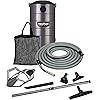VacuMaid GV50PRO Wall Mounted Garage and Car Vacuum with 50 ft. Hose and Tools.









Buy Now, Pay Later
- – Up to 36-month term if approved
- – No impact on credit
- – Instant approval decision
- – Secure and straightforward checkout
Ready to go? Add this product to your cart and select a plan during checkout.
Payment plans are offered through our trusted finance partners Klarna, Affirm, Afterpay, Apple Pay, and PayTomorrow. No-credit-needed leasing options through Acima may also be available at checkout.
Learn more about financing & leasing here.
FREE 30-day refund/replacement
To qualify for a full refund, items must be returned in their original, unused condition. If an item is returned in a used, damaged, or materially different state, you may be granted a partial refund.
To initiate a return, please visit our Returns Center.
View our full returns policy here.
Recently Viewed
Features
- Includes 50' hose, hanger, caddy, wands, dusting brush, and floor/upholstery tools
- Galvannealed steel and powder-coated for corrosion-resistant lifetime use. 7 gallon dirt capacity.
- Big 5.7" Ametek Lamb motor, up to 75% more life than comparative brands.
- Sealed HEPA-style bag - No messy cans to empty or filters to clean
- This system mounts quickly & easily to the wall eliminating tipping over
Brand: VacuMaid
Special Feature: Bag, HEPA
Filter Type: Cartridge
Included Components: Brush, Crevice Tool, HEPA Filter, Nozzle
Is Cordless?: No
Brand: VacuMaid
Special Feature: Bag, HEPA
Filter Type: Cartridge
Included Components: Brush, Crevice Tool, HEPA Filter, Nozzle
Is Cordless?: No
Capacity: 7 Gallons
Wattage: 550 watts
Hose Length: 50 Feet
Form Factor: Wall-Mount
Color: Slate Gray
Model Name: Garage Vacuum
Product Dimensions: 13"L x 13"W x 24"H
Noise Level: 68 dB
Amperage: 15 Amps
Manufacturer: Lindsay Manufacturing, Inc.
Number of Items: 1
Controller Type: Push Button
Motor Horsepower: 0.74 Horsepower
Portable: No
Number of Power Levels: 1
Indoor/Outdoor Usage: Outdoor
Finish Type: Powder Coated
UPC: 736211369185
Part Number: GV50PRO
Item Weight: 30 pounds
Item model number: GV50PRO
Is Discontinued By Manufacturer: No
Finish: Powder Coated
Material: galvannealed steel
Item Package Quantity: 1
Special Features: Bag, HEPA
Usage: Floor
Batteries Included?: No
Batteries Required?: No
Warranty Description: 5 years.
Date First Available: May 25, 2012
Frequently asked questions
To initiate a return, please visit our Returns Center.
View our full returns policy here.
- Klarna Financing
- Affirm Pay in 4
- Affirm Financing
- Afterpay Financing
- PayTomorrow Financing
- Financing through Apple Pay
Learn more about financing & leasing here.
Similar Products
Top Amazon Reviews



































